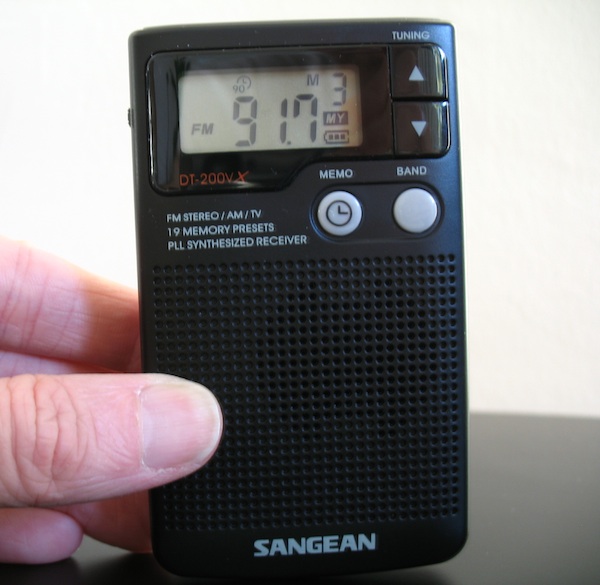
In 2009, based on some recommendations, I bought a Sangean DT-200VX portable radio. At the time, I wrote that it was good in some respects, but I was still unsatisfied, especially with its FM performance. For example, image rejection is fair, better than Sony Walkmans, but still not so great if you're in a city with lots of close-in FM transmitters. Sensitivity wasn't as good as I had hoped, and selectivity is fair or possibly even poor. It does have a forced mono mode, which is good.
Where this radio stands out is its sensitivity on AM, combined with a strong ability to receive stations even in environments without a lot of noise.
I discovered this ability two summers ago on a business trip to New York City. In my midtown hotel, I tried using my Grundig G8 to listen to one of New York's all-news stations, WCBS or WINS. Dating back from my days as an assignment editor, reporter, and anchor at an all-news station in Texas, I have the habit of listening to all-news stations, where available, while shaving, brushing my teeth, and so on.
I couldn't get either station on the G8. I also had my Sangean DT-200VX with me, and brought it into the bathroom of my hotel room. I could get a weak signal on WCBS, but a good signal on WINS. I've since found that, in other situations, the Sangean can pull in stations that many other radios can't get clearly.
So this is another radio you get for its AM performance. FM is passable, but with the deficiencies I've already noted.
The radio is easy to use. It has 19 presets, which can be used for AM or FM stations. It also could pick up analog TV audio on the old channels 2 through 13. That function is obsolete with the conversion to digital TV transmission in the United States two years ago. Sangean now sells a model that's just an AM/FM radio, the DT-200X. It appears to be otherwise identical to the DT-200VX.
When off, the radio displays a clock. The display is backlighted whenever any button is pressed. There's no alarm function, unfortunately.
On the side, you can choose to have the speaker on or off. Just putting headphones into the headphone jack won't shut off the speaker. There's a reason: Sangean supplies an FM antenna wire that plugs into the jack, for use when the speaker is on. That wire isn't needed when headphones are used, because the headphone wire serves as the antenna.
As I mentioned before, the same switch is also used to select between stereo and mono reception on FM when the headphones are used. On a weak signal, a mono FM signal will be much less noisy than it will be when it's being received in stereo.
Still, the FM performance should be a lot better than it is. The AM performance is very good. The audio bandwidth is 4 kHz. The "Dynamic Bass Boost" switch makes the built-in speaker sound much less tinny than it would otherwise. With headphones, it adds a pleasantly warm tone to the sound. It's not a boom-tube kind of sound at all.
One note: if you take it outside the Western Hemisphere, you'll have to reset the channel spacing for the AM band from 10kHz to 9 kHz. (These same instructions apply to the Sangean DT-400W AM/FM/weather band radio.) It's not documented in the manual, so here's how you do it:
- Turn the radio off.
- To go from 10 kHz to 9 kHz spacing, simultaneously press the power button and the up tuning button.
- To go from 9 kHz to 10 kHz spacing, simultaneously press the power button and the down tuning button.
You should see a brief indication on the display that the spacing has changed.
This procedure may erase some or all your memory presets.
Also similar to the DT-200VX is Sangean's DT-400W, which includes the ability to receive National Weather Service broadcasts.